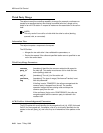
ASAI and Call Control
4-60 Issue 7 May 1998
Third Party Merge
The adjunct uses this controlling capability to merge (for example, conference or
transfer at a specified station) two existing controlled calls into a single call on
behalf of an on-ECS station. A request is made over the association of the call on
hold.
NOTE:
This only works if one call is on hold while the other is active (alerting,
queued, held, or connected).
Information Flow
The adjunct expects a response to its request.
The ECS either:
— Merges the two calls after it has validated the parameters, or
— Denies the request if the calls and specified station are not specified or are
not in the correct state
Third Party Merge Parameters
ACK (Positive Acknowledgement) Parameters
The ECS replies with a call identifier for the merged call (call_id), UCID (Universal
Call ID) for the merged call, if available, a list of up to six party identifiers for the
parties on the call (party_id), and a list of up to six extensions of the parties on the
call.
common_
party_id
[mandatory] Identifies the common endpoint with regard to
the held call. This station must have a call on hold and one
active (talking) state call.
call_id [mandatory] The call_id of the active call.
conf/trans_
flag
[mandatory] The type of merge (Conference/Transfer) is set
with this parameter.
If the flag is set to TRANSFER, the calls are merged and the
common party is dropped from the call. The transfer
operation merges the two existing calls and drops the
common party from the call.
If the conf/trans_flag is set to CONFERENCE, the calls are
merged together and the common party is retained in the
resultant call.


















